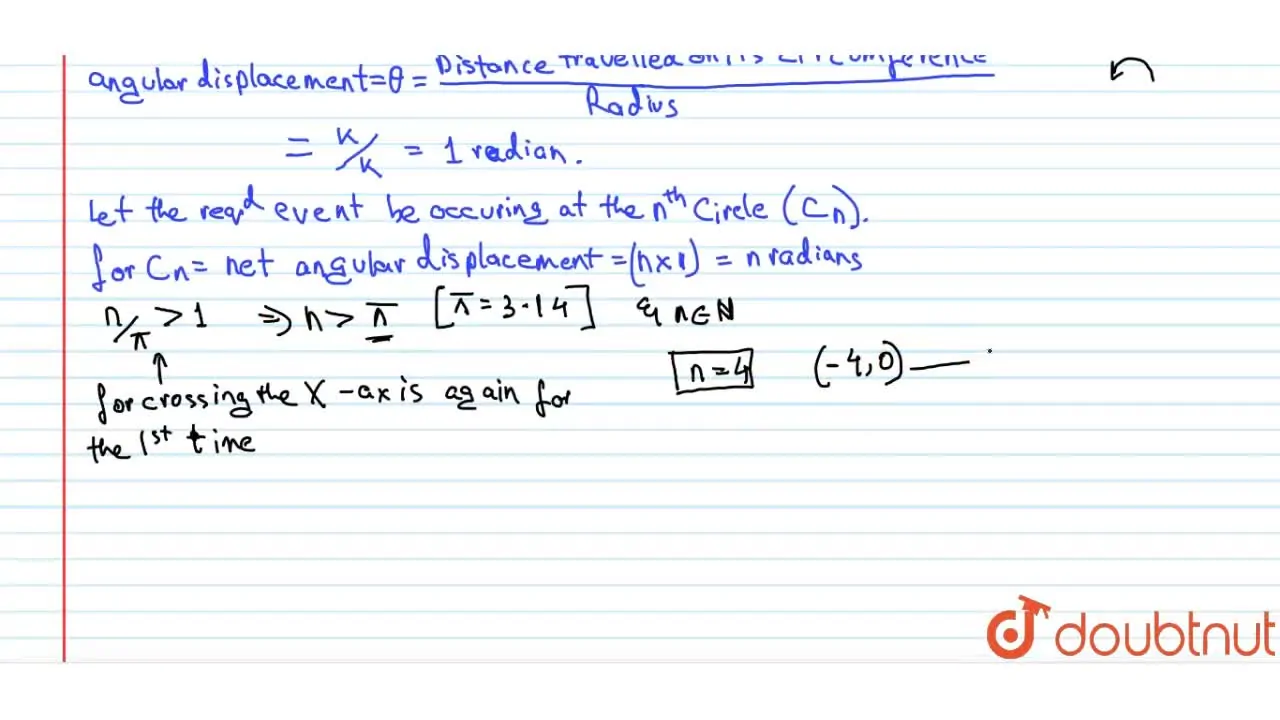For each natural number k, let Ck denotes the circle with radius k units and centre at the origin. On the circle Ck, a particle moves k units in the counter clockwise direction. After completing its motion on Ck, the particles moves to Ck+l , in some well defined manner, where l>0. The motion of the particle continues in this manner.
Answer the following question based on above passage :
Let l= 1, the particles starts at (1, 0),If k∈N and l = 1, the particles cross x-axis again atSolution in Bengali
(3, 0)
(1, 0)
(4, 0)
(2, 0)
Step by step video & image solution for For each natural number k, let C_k denotes the circle with radius k units and centre at the origin. On the circle C_k, a particle moves k units in the counter clockwise direction. After completing its motion on C_k, the particles moves to C_(k + l) , in some well defined manner, where l gt 0. The motion of the particle continues in this manner. Answer the following question based on above passage : Let l= 1, the particles starts at (1, 0),If k in N and l = 1, the particles cross x-axis again at by Maths experts to help you in doubts & scoring excellent marks in Class 11 exams.
Related Playlists
Similar Questions
Divide the join of points P(2, 5) and Q(-7, 4) in the ratio 1 : 2
internally03:43View SolutionIf x=−5+2√−4, find the value of x2+4.
03:26View SolutionFor each natural number k, let C_k denotes the circle radius k centimeters in the counter-clockwise direction.After completing its motion on C_k, the particle moves to C_[k+1] in the radial direction. The motion of the particle continues in this manner. The particle starts at (1,0).If the particle crosses the the positive direction of the x-axis for first time on the circle C_n,then n equal to
02:43View SolutionLet C_k = .^nC_k, for 0 lt= k lt=n and A_k = ((C_(k-1)^2,0), (0,C_k^2)) for k gt= 1 and A_1+A_2+...+A_n = ((k_1,0), (0,k_2)), then
07:09View SolutionIf Ck is the coefficient of xk in the expansion of (1+x)2005 and if a,d are real numbers then 2005∑k=0(a+kd).Ck =
View SolutionFor each natural number k. Let Ck denotes the circle with radius k centimetres and centre at origin. On the circle Ck a particle moves k centrimetres in the counter-clockwise direction . After completing its motion on Ck the particle moves to Ck+1 in the radial direction . The motion of the particle continue in this manner. The particle starts at ( 1,0). If the particle crosses the positive direction of the X -axis for the first time on the circle Cn, then n=__________________.
View SolutionFor each positve real number k, let Ck denotes the circle with centre at origin and radius k units. On a circle Ck particle α moves k units in the counter-clockwise direction. After completing its motion on Ck, the particle moves onto the circle Ck+1 in same well defined manner, where r>0. The motion of particle continues in this manner.
Let k∈l'andr=1, particle moves in the radial direction from Ck to Ck+1. If particle starts from the point (−1,0), thenView SolutionFor each positve real number k, let Ck denotes the circle with centre at origin and radius k units. On a circle Ck particle α moves k units in the counter-clockwise direction. After completing its motion on Ck, the particle moves onto the circle Ck+1 in same well defined manner, where r>0. The motion of particle continues in this manner.
Let k∈l+andr∈R, particle moves tangentially from Ck to C_(k+r')suchtˆ≤n>hoftan≥ntisequal→kunitsitself.Ifpartic≤⋆tsomtehp∮(2,0), thenView SolutionFor each positve real number k, let Ck denotes the circle with centre at origin and radius k units. On a circle Ck particle α moves k units in the counter-clockwise direction. After completing its motion on Ck, the particle moves onto the circle Ck+1 in same well defined manner, where r>0. The motion of particle continues in this manner.
Let the particle starts from the point A(2,0) and moves π2 units on circle C2 in the counter clockwise direction, then moves on circle C3 along tangential peth, let this straight the (tangential path traced by particle) intersect the circle C3 at points A and B. then tangents at A and B intersect at02:43View Solutionमाना की प्रत्येक प्राकृतिक संख्या k के लिए CK,k सेमी त्रिज्या तथा मूलबिन्दु पर केंद्र वाले वृत्त को निरूपित करता है। वृत्त Ck पर एक कण वामावर्त दिशा में K सेमी घूमता है। Ck पर अपनी गति करने के बाद यह Ck+1 पर त्रिज्या दिशा में चलता है। कण की गति इसी प्रकार चलती रहती है। कण अपनी गति (1,0) से शुरू करता है। यदि कण x-अक्ष के धनात्मक दिशा में प्रथम बार Cn पर काटता है तो n=.....
04:57View SolutionIf Ck is the coefficient of xk in the expansion of (1+x)2005 and if a,d are real numbers then 2005∑k=0(a+kd).Ck =
03:15View Solutionयदि 18∑k=0k.18Ck=a18∑k=01.18Ck, तो a का मान है
02:39View SolutionFor each natural number k, let Ck denotes the circle radius k centimeters in the counter-clockwise direction.After completing its motion on Ck, the particle moves to Ck+1 in the radial direction. The motion of the particle continues in this manner. The particle starts at (1,0).If the particle crosses the the positive direction of the x-axis for first time on the circle Cn,then n equal to
03:51View SolutionFind the sum 10∑k=0.20Ck.
04:28View SolutionIf for n∈N,2n∑k=0(−1)k(^(2n)Ck)2=A, then find the value of 2n∑k=0(−1)k(k−2n)(^(2n)Ck)2.
02:17View SolutionIf n and k are positive integers, show that 2k(.nC0)(.nCk)−2k−1(.nC1)(.n−1Ck−1)+2k−2(.nC2)((n−2k−2)).−...+(−1)k(^nCk)+(.n−kC0)=(.nCk)where(.nCk) stands for .nCk.
05:48View Solution


